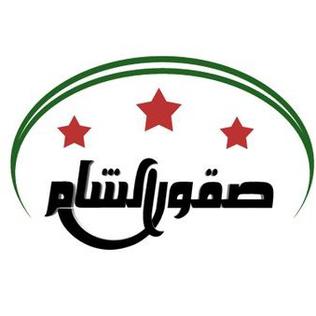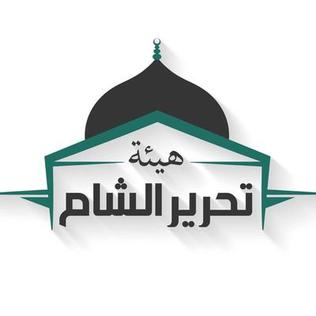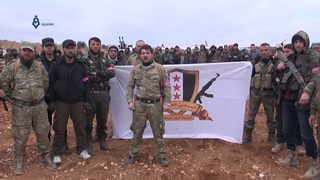
Idlib Governorate is one of the fourteen governorates (provinces) of Syria. It is situated in northwestern Syria, bordering Turkey. Reports of its area vary, depending on the source, from 5,933 km² to 6,097 km². The Governorate had a pre-war population of 1,464,000. The provincial capital is Idlib.

Between 2011 and 2017, fighting from the Syrian Civil War spilled over into Lebanon as opponents and supporters of the Syrian Arab Republic travelled to Lebanon to fight and attack each other on Lebanese soil. The Syrian conflict stoked a resurgence of sectarian violence in Lebanon, with many of Lebanon's Sunni Muslims supporting the rebels in Syria, while many of Lebanon's Shi'a Muslims supporting the Syrian regime which is led by Bashar Al-Assad, whose Alawite minority is usually described as an offshoot of Shi'a Islam. Killings, unrest, and kidnappings of foreign citizens across Lebanon resulted.

The Suqour al-Sham Brigades, also known as the Sham Falcons Brigades, is an armed rebel organisation formed by Ahmed Abu Issa early in the Syrian Civil War to fight against the Syrian Government. It was a member of the Islamic Front and a former unit of the Free Syrian Army and the Syrian Islamic Liberation Front. They have a history of coordinating with Ahrar al-Sham and al-Qaeda's al-Nusra Front, though clashes with the latter broke out in January 2017. In March 2015, the Suqour al-Sham Brigades merged with Ahrar ash-Sham, but left Ahrar al-Sham in September 2016. Also, in September 2016, they joined the Army of Conquest which Ahrar al-Sham is also a member. On 25 January 2017, Suqour al-Sham rejoined Ahrar al-Sham, but later became independent.

The Syrian Liberation Front is a Syrian rebel group formed as a merger of Ahrar al-Sham and the Nour al-Din al-Zenki Movement, two hardline Sunni Islamist groups and the two largest rebel groups in northwestern Syria behind their main rival, Tahrir al-Sham. In its formation statement on 18 February 2018, the Syrian Liberation Front called on other rebel groups to join it, and stated that it was formed as a result of an initiative by the Syrian Islamic Council. It is part of the National Front for Liberation.
The Lebanese–Syrian border clashes are an ongoing series of clashes on the Lebanese-Syrian border caused by the ongoing Syrian Civil War.

The Battle of Qalamoun started on 15 November 2013, with air strikes on the town of Qara, in the strategic Qalamoun region, in an attempt by the Syrian Army to cut rebel supply lines to Damascus from Lebanon. The strategic region had been used by rebel forces as a rear base for its operations around the capital Damascus. For its part, government forces had been using the nearby highway to link Damascus with the central Homs province and had multiple weapons depots in the area. The battle was primarily led on the rebel side by the Al-Nusra Front.

The Qalamoun offensive was launched by the Syrian Army, in coordination with the Lebanese militia Hezbollah, during the Syrian Civil War against remnant rebel forces following the previous Battle of Qalamoun which resulted in the military securing all of the towns in the region.

The Qalamoun offensive was an offensive led by the Iranian-backed militia Hezbollah, supported by the Syrian Army, during the Syrian Civil War, against the al-Nusra Front and other Syrian opposition forces entrenched in the mountains of the Qalamoun region.

The Idlib Governorate clashes were military confrontations between Syrian rebel factions led by Ahrar al-Sham and their allies on one side and the al-Qaeda-affiliated Jabhat Fatah al-Sham and their allies on the other. After 7 February, the clashes also included Jund al-Aqsa as a third belligerent, which had re-branded itself as Liwa al-Aqsa and was attacking the other combatants. The battles were fought in the Idlib Governorate and the western countryside of the Aleppo Governorate.

Hay'at Tahrir al-Sham, commonly referred to as Tahrir al-Sham and abbreviated HTS, also known as al-Qaedain Syria, is an active Salafist jihadist militant group involved in the Syrian Civil War. The group was formed on 28 January 2017 as a merger between Jabhat Fateh al-Sham, the Ansar al-Din Front, Jaysh al-Sunna, Liwa al-Haqq, and the Nour al-Din al-Zenki Movement. After the announcement, additional groups and individuals joined. The merged group is currently led by Jabhat Fatah al-Sham and former Ahrar al-Sham leaders, although the High Command consists of leaders from other groups. Many groups and individuals defected from Ahrar al-Sham, representing their more conservative and Salafist elements. Currently, a number of analysts and media outlets still continue to refer to this group by its previous names, al-Nusra Front, or Jabhat Fateh al-Sham. The Ansar al-Din Front and Nour al-Din al-Zenki Movement have since split off from Tahrir al-Sham.

The Turkish-backed Free Syrian Army, partially reorganized as the Syrian National Army by Turkey since 30 May 2017, is an armed Syrian opposition structure mainly composed of Syrian Arab and Syrian Turkmen rebels operating in northern Syria, mostly being a part of Operation Euphrates Shield or groups active in the area that are allied to the groups participating in the operation.
The following is a timeline of the Syrian Civil War from May to August 2017. Information about aggregated casualty counts is found at Casualties of the Syrian Civil War.

The Northern Democratic Brigade is a Free Syrian Army unit, led by Alexander Khalil, that is closely allied to the Syrian Kurdish YPG and YPJ in Afrin Canton since 2014. It also joined the Syrian Democratic Forces (SDF) in November 2015. The initial members of the group originated from Jabal Zawiya in Idlib, and it has recruited Arabs from Idlib, Aleppo, and other cities in northern Syria since allying with the YPG.

The Qalamoun offensive was a military operation launched by Hezbollah, the Syrian Armed Forces, and later the Lebanese Armed Forces, against members of Tahrir al-Sham and the Islamic State of Iraq and the Levant on the Lebanon–Syria border. The Lebanese Army denied any coordination with Hezbollah or the Syrian Arab Army.

The Qalamoun Shield Forces are a militia formed by natives of the Qalamun Mountains that fight for the Syrian government during the Syrian Civil War. Originally a small auxiliary and self-defense group, QSF grew into relatively large and well-equipped paramilitary force that operates nationwide. Currently led by Firas Jaz'ah, the Qalamoun Shield Forces are closely affiliated with the 3rd Armoured Division.

On 19 February 2018, heavy clashes erupted between the newly-established Syrian Liberation Front, which consists of Ahrar al-Sham and the Nour al-Din al-Zenki Movement, backed by the Suqour al-Sham Brigades, and Tahrir al-Sham (HTS) in the western Aleppo Governorate. The conflict soon spread to the Idlib Governorate and the SLF captured several towns from HTS. A ceasefire between the two groups was reached on 24 April 2018. Fighting again resumed on January 1, 2019, ending with a total HTS military victory on January 9th.

On 17 April 2018, rebel groups in the eastern Qalamoun Mountains pocket, led by Jaysh al-Islam, reached a surrender agreement with the Syrian Army and Russia. The agreement came after 2 weeks of negotiations that began with a Syrian Army ultimatum on 3 April. Around 1,500 rebels handed over heavy weapons and equipment to the Syrian Army, and were evacuated by 124 buses in 4 convoys to Turkish-held areas in the northern Aleppo Governorate along with their families, totaling around 5,000 people. On 25 April, the last batch of rebels and their families left the eastern Qalamoun pocket, and the region came under full Syrian government control.

The Idlib demilitarization is an ongoing agreement between Turkey and Russia to create a demilitarized zone in Syria's rebel held Idlib Governorate, to be patrolled by Russian and Turkish militaries. On 17 September 2018, the Russian president Vladimir Putin and Turkish president Recep Tayyip Erdoğan, reached an agreement to create a buffer zone in Idlib.
























